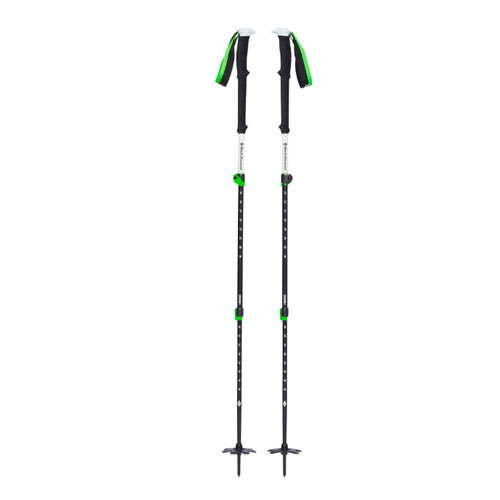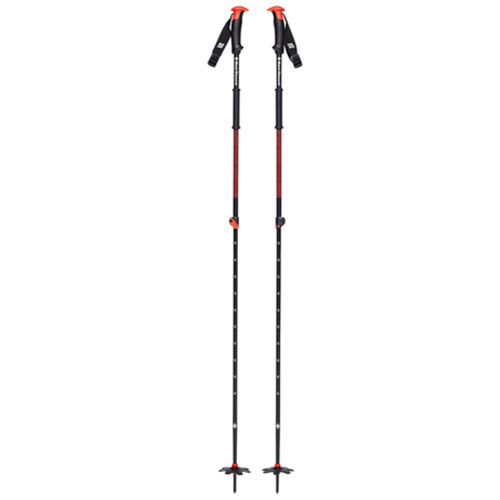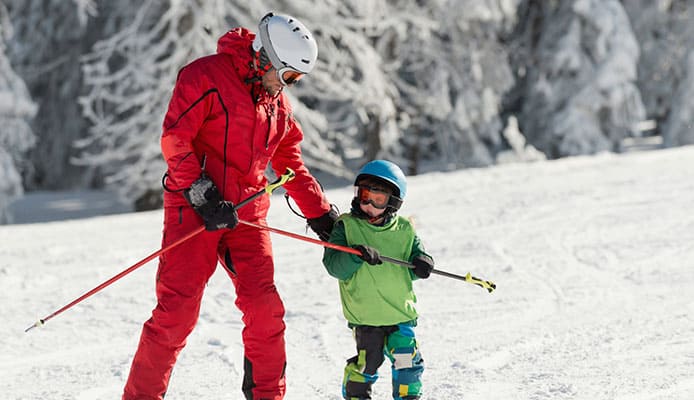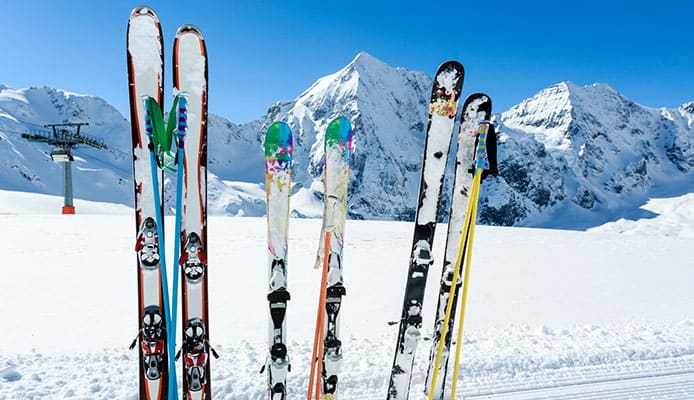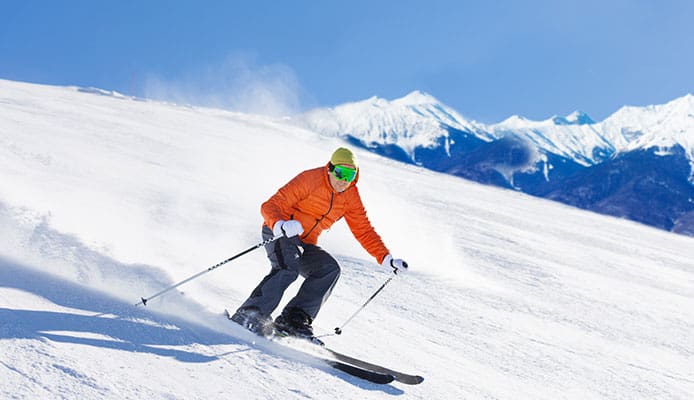
For many skiers, ski poles are the most misunderstood and underestimated piece of equipment. But poles are a versatile addition to your arsenal of ski gear. With poles, skiers will have better balance and rhythm in their turns, as well as an aid to correctly position their bodies. Plus, poles are handy for propelling skiers across flat sections of the mountain. For beginner skiers, learning how to use poles properly is essential, that’s why having the most efficient ski poles is crucial. But it can be challenging to determine what makes a quality ski pole and even what features you should consider when looking for a pair of poles.
To help skiers in their search, we’ve created our guide that outlines precisely what makes a quality ski pole and what features to look for in the numerous designs on the market. With our list of the ten best ski poles in 2023, you’re one push in the right direction to finding top rated poles that will assist you in conquering the slopes.
OUR TOP PICK
Black Diamond Expedition 3
- Stand Out Features - Why We Love It
- Versatile, 4 season design
- 3 sections are fully adjustable
- Use all year round for skiing and hiking
- Made of 100% aluminum and durable for rugged mountain use
- FlickLocks adjust the sections and keep them open during use
- Extended foam grip to easily manipulate and position the poles
- Great for beginner and expert skiers
- Collapsible design is easy to transport
- Powder and trekking baskets included
Useable Length: 22.2-48.8 inches/24.2-54.6 inches
Collapsed Length: 22.2 inches/24.2 inches
Weight: 1 pound 2 ounces
Material: 100% aluminum
Series: Touring
Number of Poles: 2
Accessories: Powder and trekking baskets
EDITORS CHOICE
Salomon Artic 100
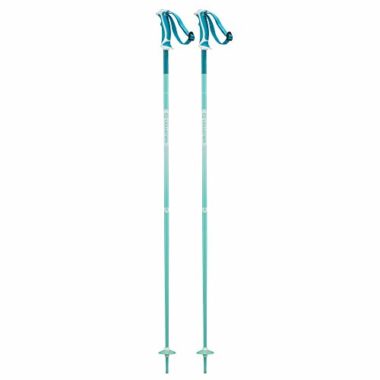
- Stand Out Features - Why We Love It
- Aluminum is lightweight and strong
- All-mountain design can be used on a variety of terrain and snow conditions
- Aluminum is stiff to ensure the poles never bend or snap
- All-mountain basket lets these poles perform in various snow conditions
- Stable on groomed and ungroomed trails
- Standard strap keeps the pole securely in your hand
- Single body design comes in a variety of lengths
- Variety of color options available
Lengths: 110, 115, 120, 125, 130, 135 centimeters
Weight: 100 grams
Material: Aluminum
Series: All-mountain
Number of Poles: 2
Accessories: All-mountain basket
BEST VALUE
Salomon Kaloo Junior Alpine
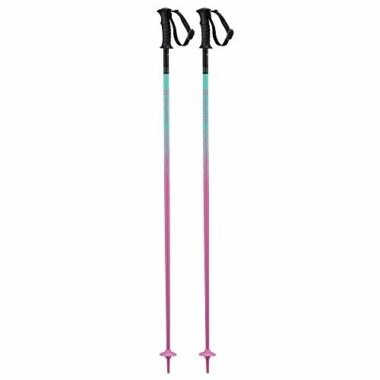
- Stand Out Features - Why We Love It
- Optimized for junior skiers
- Variety of lengths suited for shorter statures
- Lightweight design is easy to carry and control
- Durable for bearing weight
- Compact grip is more comfortable for small hands
- Junior strap for security
Lengths: 70, 74, 80, 85, 90, 95, 100, 105 centimeters
Weight: 130 grams
Series: Junior
Number of Poles: 2
Accessories: Junior baskets and straps
Winget Carbon Fiber All-Mountain

- Stand Out Features - Why We Love It
- Super light and sturdy design
- Made of 100% carbon fiber
- Great for training and skiing
- Catch speed on the mountain
- Ergonomically designed handle for comfort
- Straps keep the skier’s grip secure
- Manganese steel tip is anti-wear for longer use
- Removeable mud basket helps position the pole in snow
- Perfect for backcountry skiing
Product Dimensions: 4.5 x 43.8 x 1.2 inches
Weight: 1.4 pounds
Material: Carbon fiber, alloy, nylon, plastic
Series: All-mountain
Number of Poles: 2
Accessories: Strap and basket
Zipline Carbon Composite
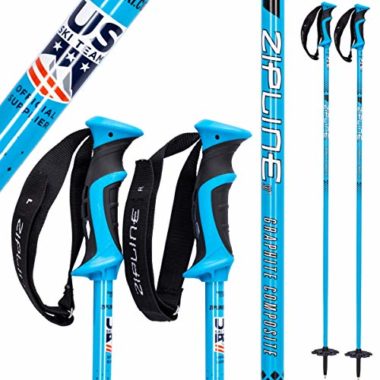
- Stand Out Features - Why We Love It
- US Ski Team Official Supplier brand
- Graphite carbon composite technology
- Reduces pole plant vibration for more stability
- Lightweight and durable design
- Unique taper from top to tip for a lighter swing weight
- Zip touch dual density grip is contoured for comfort
- Velcro adjustable straps
- Large powder baskets for precise pole placement
Lengths: 96, 100, 102, 105, 107, 112, 117, 122, 127, 132 centimeters
Weight: Ultra light
Material: Graphite Kevlar hybrid, carbon
Series: Racing, freestyle, moguls
Number of Poles: 2
Construction: Tapered shaft
Basket Type: Small hexagon
Grip: Dual density thermoplastic
Accessories: Baskets and straps
Black Diamond Traverse Pro
- Stand Out Features - Why We Love It
- Pro-level
- Made of aluminum for durability and sturdiness
- Collapsible ski pole
- FlickLock Pro is fully adjustable
- Innovative breakaway wrist strap
- Lockable release function
- Redesigned grip
- Ideal for touring
- Comfortable for a full day on the mountain
Lengths: 145 and 155 centimeters
Weight: 1 pound
Material: Aluminum
Series: Touring
Number of Poles: 2
Accessories: Straps and baskets
K2 Kid’s Sprout Adjustable
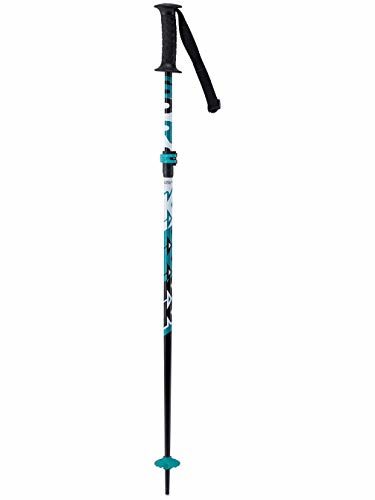
- Stand Out Features - Why We Love It
- Fully adjustable from 75 to 105 centimeters
- Will last through multiple ski seasons and growth spurts
- Aluminum shaft is durable and reliable
- Rubber grip and adjustable web straps are comfortable for little hands
- 60mm baskets are the perfect size
- Steel tip ensures secure placement
Length: 75 to 105 centimeters
Weight: 10.6 ounces
Material: Aluminum
Series: Kids
Number of Poles: 2
Accessories: Straps and baskets
WSD Downhill
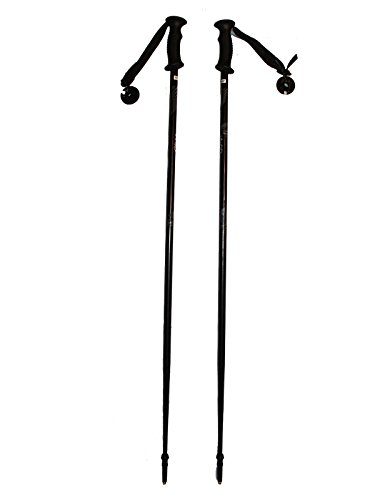
- Stand Out Features - Why We Love It
- Made of aircraft aluminum
- High strength and stress resistance
- Lightweight to catch high speeds
- Screw on baskets are easy to replace in case of damage
- Perfect for backcountry skiing
Weight: Lightweight
Material: Aluminum 7075
Series: Downhill
Number of Poles: 2
Accessories: Screw on baskets
Rossignol Tactic Carbon Safety

- Stand Out Features - Why We Love It
- Thinner 14mm diameter
- Lightweight
- Easy to place
- Shaft features 20% carbon for lightweight and durable feel
- Grip has a safety bi-mat for security even with ski glvoes
- 60mm basket is great for freestyle
- Carbide tip easily breaks through snow
Length: 125 centimeters
Weight: 10.6 ounces
Material: Carbon
Series: Freestyle
Number of Poles: 1
Accessories: 60mm basket
Scott SMU Pro Taper
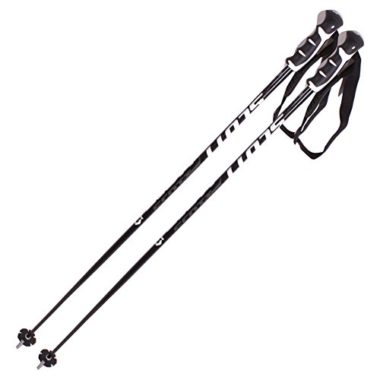
- Stand Out Features - Why We Love It
- Tapered design
- Blend of carbon and fiberglass for the benefits of both materials
- Durable for downhill and touring
- Notch strike grip is anatomically engineered
- Thermoplastic rubber and polypropylene grip for comfort and security
- Disc basket is aerodynamic and efficient
- Ice tip for packed snow conditions
Length: 44 inches
Weight: 1.69 pounds
Material: Fiberglass, carbon, thermoplastic, polypropylene
Series: Downhill, touring
Number of Poles: 1
Accessories: Disc basket and ice tip
How To Choose The Best Ski Pole – Buying Guide
Poles are a versatile piece of gear, but not all models function the same. A variety of features can give different pairs of ski poles advantages and disadvantages for different types of skiers. Below we have highlighted the most important features that make a quality ski pole, which you should consider when searching for your new equipment.
Material
The material of a ski pole determines the strength, durability, flexibility, and affordability of a design. The three most common materials used for poles are aluminum, carbon fiber, and fiberglass. Additionally, a composite ski pole may use a blend of two different materials.
Aluminum poles are the most popular choice because they are affordable, but still incredibly strong to withstand extended use on the mountain. The aluminum is stiff and lightweight, which gives sufficient support for the skier to find their balance and make their turns. Aluminum is also the most affordable material, but you may find that there is still a price range. Due to different grades, aluminum may be more expensive or less expensive. A high-grade aluminum will be more costly because it is lighter and stronger than a low-grade aluminum.
Carbon poles are the strongest and lightest material that has a little bit more flexibility than aluminum. These types of ski poles are preferred by experienced skiers who enjoy the benefits of a lightweight body and narrow shaft, which makes all-day skiing more fun. The only downside is that carbon fiber is the most expensive material, so be prepared to invest in your new poles.
Fiberglass is another material that poles can be made of, but most poles will not be made entirely of this material because of the increased weight. Instead, fiberglass may be blended with another material to make a pole durable, strong, and long-lasting.
Composite ski poles are made of blended materials, which attempts to offer the best qualities of each material into one design. Common blended materials are carbon fiber and fiberglass, which has enhanced shock absorption. Carbon and fiberglass are the best materials for the backcountry terrain.
Weight
When choosing cross-country skiing equipment or backcountry ski gear, weight is an important consideration in the design of their poles more so than that of downhill skiers. This difference is that poles for cross-country and backcountry trails are used to propel the skier forward on flat surfaces. Downhill ski poles are better used to help a skier keep the balance, but gravity keeps the skier moving down the mountain so that the poles are used less to push the weight.
Carbon poles are often the lightest weight, but this isn’t entirely because of the material. Aluminum can be lighter than carbon fiber, but the difference is in the diameter of the pole’s shaft. Carbon fiber poles will often have a narrower shaft to save on weight, whereas aluminum poles can be thicker. The narrow diameter means a lower stress tolerance, which can lead to issues for some skiers who firmly plant or lean on their poles.
Skiers should do their best to balance weight with durability and consider the type of ski trails they will be skiing. Additionally, men’s poles will be heavier than women’s poles because of the added length.
Features
Poles are just as important as your other ski gear like ski helmets and ski gloves. What many skiers don’t understand is how the features of a pole assist in their performance on the slopes. Poles are used for stabilization and support when making turns skiing. The pole can be used at the initiation of a turn to transfer energy as you switch directions. Each time you make a turn, the pole should touch the snow slightly ahead of your boots and on their correlating side.
Poles can also help skiers read the terrain through the small sensations that travel up the body and into the handle. Adjustable poles and collapsible poles shouldn’t falter in their readings because they have a segmented shaft. All ski poles should be sensitive enough to help skiers navigate the terrain underfoot.
Size
The size of the poles is the length of the pole, which is typically measured in inches or centimeters. But learning how to size poles can be challenging because it will depend on the skier and the type of skiing they are participating in. The four most common sizes of poles are standard, short, long, and adjustable.
Standard ski poles rest at elbow height or just around your elbows. Alpine touring poles are an example of poles that usually rest at standard height. Your arm should rest comfortably at about 90 degrees while you’re holding the pole and the tip should be adequately planted into the ground.
Short ski poles are best for backcountry skiers. Freestyle poles are also shorter so that they don’t catch on any park features. In general, a shorter pole will reduce any damage or hits from trees and rocks on the trail. Backcountry skiers can comfortably take a couple of inches off of the length of the pole, but freestyle skiers may want to take up to 4 inches or 10 centimeters.
Cross-country skiers mostly use long poles because they can use the extra length to propel themselves forward or get traction when going uphill. Ski poles will often rest at armpit height, which is a significant jump from the elbow.
Adjustable ski poles are an excellent solution for ski touring poles, backcountry poles, and junior poles. For ski touring and backcountry skiers, a telescoping ski pole can help them adjust the length of the pole while they are on their trip. The adjustment is helpful because these types of skiers need extra length going up, but a shorter length going downhill. Adjustable ski poles let them get the size they need in one design so that they aren’t carrying any extra weight. For junior skiers who are continually growing, adjustable poles are also a great idea because they’ll last through multiple seasons or growth spurts.
Type
The type of ski pole that you use goes hand in hand with what type of skiing you do. Backcountry, racing, freestyle, and cross-country skiing all require a different type of ski pole.
The best ski poles will have larger baskets, which will prevent them from sinking too deeply into the snow. Adjustable poles are the most efficient ski poles for backcountry skiing, and you may want to consider a lightweight and durable material. Additionally, a shorter length can help you avoid any collisions with trees or rocks.
Racing requires a unique pole that is custom shaped and design to follow the curve of your body. The shaft will be strong, aerodynamic, and have a curve shape, which ensures you don’t get caught on the race gates and can move the most efficiently.
Freestyle ski poles are also shorter poles, which helps the skier avoid getting caught on any park features. The shorter poles should still be extremely durable and lightweight so that you aren’t trying any complicated tricks with heavy gear.
Cross-country ski poles will be the longest design because these types of skiers need the leverage to push themselves forward. Downhill ski poles are drastically shorter than these poles, so don’t be concerned if your hands are resting closer to your armpits.
Comfort
No matter what type of skier you are, your ski poles should be comfortable to use. You are, after all, using them for important advantages like a better balance. The main concern for comfort is the fit of the pole. Skiers should ensure that they have correctly sized their pole and are using the correct length for their ski adventures.
Additionally, the handle and strap should be comfortable to use. The ski poles should have an ergonomic grip that features a few notches for security. Most grips are made of durable plastic with rubber elements. The strap should easily fit around your wrist without digging or tugging.
You might also be interested in:
How To Choose Ski and Snowboard Goggles
Effectiveness
The effectiveness of a ski pole will be dependent on the skier and their skill level. It is possible to ski without poles, and you’ll often see beginners learning how to ski with just their skis and other ski gear. It is also very common that people teach their kids to ski without poles.
Poles themselves are very effective at supporting a skier and helping them enhance their performance. With all the turns, shifts, and angles, the most efficient ski poles can assist you in having a great day in the snow. But it will take time to learn how to properly use and place poles, hence why the effectiveness will be up to the individual skier and their experience level.
Use
Poles are mainly used to support a skier’s body on the trail. Whether they are turning through trees, navigating moguls, or racing down the mountain, poles can effectively support a skier’s weight and adjust their placement to enhance their overall performance. Backcountry and cross-country skiers will rely heavily on their poles to propel them forward on flat surfaces, and downhill skiers need the stability to carve turns.
Basket
The basket of the ski pole is a small plastic piece that is the position just before the tip of the pole. The basket stops the ski from sinking too deeply into the snow, which would cause you to lose your ski pole. Ski pole baskets also have their sizes, which depend on the terrain and type of skiing.
Small baskets are meant for alpine touring ski poles and on-piste skiers. However, cross-country skiers gear also lists smaller baskets because they don’t sink in deeply and don’t interfere with the arm swinging action.
Large baskets are meant for powder snow, where you need a larger surface area to stop the pole from sinking in. Adjustable ski poles, which are ideal for backcountry skiing, should have large baskets for deeper snow. However, a few downhill poles may have interchangeable baskets for powder areas on the mountain.
Race baskets are the smallest baskets because you don’t want the piece to get caught as you are traveling at high speeds. The smaller size also reduces weight and increases aerodynamics.
Strap
Poles should come with a strap that can be loosely fitted around your wrist, which prevents you from becoming separated from the pole. The strap is an excellent feature if you ever fall, stumble, or lose grip on your pole. Most straps are adjustable, which makes it easy to get on and off. Some straps include a quick release feature, which will break away should you ever take a bad fall where it may be safer to let go of your pole instead of holding on.
Grip
The grip of a ski pole is where your hand will rest while you use the ski pole. Most grips feature a durable plastic and rubber combination, which are ergonomic in design and comfortable to use for extended periods. Some grips even have indentations or notches to make them easier to hold with gloves or mittens.
Men’s poles may have a different grip than women’s poles, which is due to the difference in the size of hands. Additionally, children’s or junior’s poles may have smaller grips, which are suitable for little hands. If you are concerned about the size of a grip on a unisex design, you can check ski pole reviews. Many buyers will comment on how comfortable a grip is and what size you should expect it to be suited for.
FAQs
Q: What do poles for skis do?
Poles are pieces of ski gear that are designed to enhance your performance skiing and improve your skill on the mountain. Poles are used to help skiers find their proper placement and alignment when making turns. The poles can also be used for support or to propel yourself across flat surfaces. With poles, a skier has better balance, rhythm, and coordination. But don’t be discouraged by the learning process. While poles may feel clumsy at first, with practice, you’ll soon excel at using them and unlock their benefits. Additionally, poles can actually help you release your ski bindings, without bending down.
Q: How to pole plant?
Pole planting is the skill that skiers need to acquire in order to unlock all the benefits of their poles. For pole planting, you’ll want to keep your arms in front of your body and to the side. But your arms should always be at a relaxed distance. As you make your turns, at the end of each turn, you bring your pole forward and place it on the mark just ahead of your ski boot. You don’t want to apply much weight onto the pole, but still, firmly plant it into the ground. As you come into the next turn and release your edge, you plant the next pole and turn. Pole planting should be a smooth operation that is completed at the beginning of each turn and repeated until you have reached the end of your turns.
Q: What poles for skis don’t do?
While poles are durable and strong, a ski pole should never be used to stop or break a fall. Skiers who attempt to put too much weight on their poles can end up with worse injuries than if they had just fallen. Poles are meant to support your balance, rhythm, and coordination. The pole is not meant to stop you from falling once a fall has been initiated.
If you start to fall, you should try to tuck your poles up and into a position that you won’t accidentally fall on top of them. Some poles even have quick release straps in case of a fall, which ensures that you aren’t focusing on holding your pole instead of catching yourself. Poles are also not meant to be dragged at your sides or behind you. When you choose to use poles, you need to actively use your arms to properly position the pole. A dragging pole poses a danger to you and other skiers or snowboarders on the mountain.
Poles are also not meant to be dragged at your sides or behind you. When you choose to use poles, you need to actively use your arms to position the pole properly. A dragging pole poses a danger to you and other skiers or snowboarders on the mountain. If you find yourself dragging your poles, consider learning how to ski without poles first before incorporating them into your routine.
Q: How do you hold poles?
To properly hold a ski pole, you should first put your hand through the included strap. The strap should rest comfortably and loosely on your wrist. Next, you place your hand on the grip of the pole and the end of the strap. If your grip has finger grooves or notches, ensure that they are properly aligned and feel comfortable. Once your poles are in a comfortable position, you should be able to maneuver them however you need them.
A big mistake that skiers often have when learning how to hold poles is not holding onto the bottom of the strap. For skiing, it is important that you secure the strap so that it is not flopping around too much. By holding the bottom against the grip of the pole, you are also positioning your hand in the optimal location to maneuver and use your poles easily.
Q: What kind of poles do professional instructor use?
When people hear the word “professional,” they think of the absolute best. For many skiers, they believe that professional instructors will use the best or most expensive poles to guide them down the mountain. This assumption often concludes that carbon fiber is the overall best choice because it is lightweight and strong. But carbon fiber is also expensive, and continually buying these types of poles will become frustrating. You may be surprised to know that the reality is often the opposite, and professional instructors are looking for durable and affordable designs too.
Many ski instructors will accidentally break, lose, or have a ski pole stolen. Replacing expensive poles can quickly put a damper on anyone’s budget, so finding an affordable but reliable ski pole is important. Affordable poles shouldn’t be looked down upon and are often the best choice because they can be easily replaced in case of damage. The most affordable design is aluminum poles. Aluminum is a durable material, but it comes at an affordable price. Aluminum poles are also the most common type of poles for those very reasons.
Q: Are powder baskets better than regular baskets?
Not necessarily. As we mentioned, there are different basket designs because they cater to different types of skiing. A larger basket isn’t always the best choice for every skier, especially if they are trying to catch speed down a groomed trail. The ski poles for backcountry skiing will use a larger basket for powder snow, but that doesn’t work for downhill poles. Instead of correlating the large size of powder baskets as a better choice, consider all the different basket designs and which type of skier you are. For every kind of skier, there is a basket that is catered to their needs.
Q: What are self-releasing safety straps?
Self-releasing safety straps may also be called quick release straps and are a feature in some ski pole design. These types of straps have a closure that can easily be opened or broken in case of a fall. These types of straps are meant to keep skiers safer so that their poles do not accidentally hurt them. Collapsible poles and retractable poles may have self-releasing straps because they could be more likely to break in the joints from a bad fall. Telescoping poles may also have this feature for the same reason as collapsible and retractable poles.
But not all straps have a self-releasing or quick release feature. If you are unsure about whether your skis have this safety feature, check the product specifications, or read the ski pole reviews. Specifications and reviews can let you know exactly what to expect with a ski pole’s design and help you determine whether they are suitable for you.
Q: I’m a new skier – do I need ski poles?
No. The choice of whether you learn immediately to use poles will be up to you and the instructor. Many people, including children, successfully learn how to ski first without worrying about how to plant a pole. Even for adult beginners, starting to learn how to ski without a pole can be much easier than trying to learn with poles. It can be safer for beginner skiers to learn without a pole because it reduces the risk of an accident or fall with the poles in hand.
However, it is also suitable for adults to learn how to ski using poles. For some skiers, learning the basics of everything at once is better because they don’t have to learn one way and then incorporate more actions. If you feel confident about trying poles immediately, don’t be afraid to ask for a pair.
Globo Surf Overview
Skiing is a thrilling activity that both children and adults can enjoy. Skiers love to get out on the mountain and feel the cold rush of air on their face as they race down the slopes. But every skier needs the best equipment. Poles are an important part of ski gear because they can enhance a skier’s performance and skill while they navigate the mountains. But for many skiers finding the best ski poles is a challenge because they don’t know what makes a quality design or they’re unsure which pole matches their ski profile.
We have made this guide and found the ten best ski poles to help you get started in your search. Using this guide, you have everything you need to find a top-rated pair of poles. The best ski poles will be durable, lightweight, and long-lasting so that there’s no excuse not to spend some time on the slopes!
More Snow Ski Gear Reviews:
- Ski Locks
- Ski Goggles For Flat Light
- Kids Ski Goggles
- Ski Walkie Talkies
- Ski Helmet Headphones
- Ski Carry Straps
- Ski Helmets With Visors
- Ski Boots For Wide Feet
- OTG Ski Goggles
- Sunglasses For Skiing
- Kids Ski Pants
- Night Skiing Goggles
- Ski Mid-layers
- Base Layers For Skiing
- Ski Racks
- Skis For Beginners
- Ski Bags
- Gifts For Skiers And Snowboarders
- Avalanche Shovels


